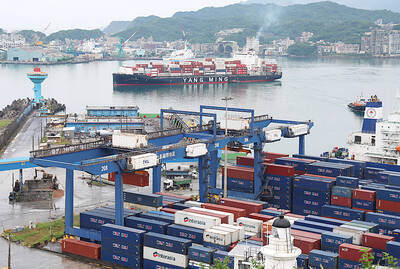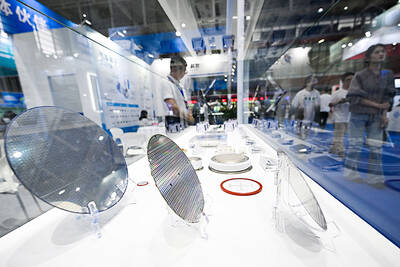Bora Pharmaceuticals Co (保瑞藥業) has acquired six brand product licenses, rights and process technologies in the US for US$38.5 million, and expects them to start contributing to revenue in the fourth quarter of this year, the company said in a filing with the Taiwan Stock Exchange yesterday.
Bora’s board of directors approved the deal with Morristown, New Jersey-based Almatica Pharma Inc, as the Taiwanese firm moves into the brand product market to diversify risks away from generic drugs, the filing said.
The deal would enable Bora to leverage its sales platforms to enter the brand product market, it said.

Photo: CNA
Established in 2008, Almatica —a US subsidiary of Alvogen Group — focuses on the development, acquisition and commercialization of pharmaceutical products. Its product portfolio includes psychiatry, pain management, anti-infective and cardiovascular treatments, the company’s Web site says.
The six brand products are Zestril, Tenormin and Tenoretic for cardiovascular treatment, and Forfivo XL, Naprelan and Fluoxetine HCL for treating central nervous system issues, Bora said.
Sales of the six drugs in the US totaled about US$220 million last year, the company said, citing data from life sciences researcher Iqvia Institute.
As the deal was conducted through Bora’s subsidiary TWi Pharmaceuticals Inc (安成藥), it would greatly bolster the generic-drug unit’s product portfolio in the US market, while reducing its concentration on generic drugs, Bora chairman Bobby Sheng (盛保熙) told an investors’ conference in Taipei yesterday.
After TWi completes its takeover of the six products’ licenses and rights, it can deploy Bora group’s contract manufacturing and development expertise for mass production, which would not only increase TWi’s profit, but also boost the parent company’s global contract manufacturing business, Sheng said.
Bora’s second-quarter net profit surged 192 percent to NT$700.83 million (US$21.92 million) from NT$239.99 million in the same period last year. That translated into earnings per share (EPS) of NT$8.95, compared with NT$3.2 a year earlier.
EPS in the first half of the year was NT$22.54, up from NT$5.57 a year earlier, while gross margin improved to 46.09 percent, from 37.12 percent, it said.
With cumulative revenue in the first half of the year jumping 220.5 percent year-on-year to NT$7.92 billion and a better business outlook, the company yesterday raised its annual revenue growth forecast to between 30 and 35 percent, from its previous estimate of 20 to 30 percent.
It also raised its gross margin forecast to between 45 and 50 percent, from its earlier projection of 45 percent.

Taiwan’s exports soared 56 percent year-on-year to an all-time high of US$64.05 billion last month, propelled by surging global demand for artificial intelligence (AI), high-performance computing and cloud service infrastructure, the Ministry of Finance said yesterday. Department of Statistics Director-General Beatrice Tsai (蔡美娜) called the figure an unexpected upside surprise, citing a wave of technology orders from overseas customers alongside the usual year-end shopping season for technology products. Growth is likely to remain strong this month, she said, projecting a 40 percent to 45 percent expansion on an annual basis. The outperformance could prompt the Directorate-General of Budget, Accounting and

Two Chinese chipmakers are attracting strong retail investor demand, buoyed by industry peer Moore Threads Technology Co’s (摩爾線程) stellar debut. The retail portion of MetaX Integrated Circuits (Shanghai) Co’s (上海沐曦) upcoming initial public offering (IPO) was 2,986 times oversubscribed on Friday, according to a filing. Meanwhile, Beijing Onmicro Electronics Co (北京昂瑞微), which makes radio frequency chips, was 2,899 times oversubscribed on Friday, its filing showed. The bids coincided with Moore Threads’ trading debut, which surged 425 percent on Friday after raising 8 billion yuan (US$1.13 billion) on bets that the company could emerge as a viable local competitor to Nvidia

BARRIERS: Gudeng’s chairman said it was unlikely that the US could replicate Taiwan’s science parks in Arizona, given its strict immigration policies and cultural differences Gudeng Precision Industrial Co (家登), which supplies wafer pods to the world’s major semiconductor firms, yesterday said it is in no rush to set up production in the US due to high costs. The company supplies its customers through a warehouse in Arizona jointly operated by TSS Holdings Ltd (德鑫控股), a joint holding of Gudeng and 17 Taiwanese firms in the semiconductor supply chain, including specialty plastic compounds producer Nytex Composites Co (耐特) and automated material handling system supplier Symtek Automation Asia Co (迅得). While the company has long been exploring the feasibility of setting up production in the US to address

OPTION: Uber said it could provide higher pay for batch trips, if incentives for batching is not removed entirely, as the latter would force it to pass on the costs to consumers Uber Technologies Inc yesterday warned that proposed restrictions on batching orders and minimum wages could prompt a NT$20 delivery fee increase in Taiwan, as lower efficiency would drive up costs. Uber CEO Dara Khosrowshahi made the remarks yesterday during his visit to Taiwan. He is on a multileg trip to the region, which includes stops in South Korea and Japan. His visit coincided the release last month of the Ministry of Labor’s draft bill on the delivery sector, which aims to safeguard delivery workers’ rights and improve their welfare. The ministry set the minimum pay for local food delivery drivers at